
|

|
|
Home Site Search Contact Us Subscribe
|
|
New York Unpacked: Reflections on Jean Holabird's "Paper City" The artist's 3D watercolors of New York City buildings go on view today in a display window of Ralph Walker's former Western Union Building (1930). By Janet Adams Strong December 17, 2019 Jean Holabird is an accomplished artist in Lower Manhattan with a distinguished legacy of tower building. Both her father and grandfather were principals of Holabird & Root, the renowned architectural firm that designed some of the world’s first skyscrapers and helped to define the Chicago School of Architecture.
Jean continues the family tradition on a parallel, but different, course. She laughingly recalls Roy Neary in the film Close Encounters of the Third Kind who becomes obsessed with the iconic landform of Devils Tower and recreates it over and over (starting mindlessly with his mashed potatoes). Jean, with similar inclinations but far greater artistry, has been making towers off and on for decades, seeded back in her college years by paintings not intended to hang on walls; her senior project at Bennington comprised large canvasses hinged together in a freestanding whole. Exactly when Holabird turned to the making of more scrutable towers is unclear but, she muses, “I’m sure it’s 9/11-related in my psyche.”
Jean Holabird witnessed the attacks on the World Trade Center from her loft four blocks north, and later processed the experience in a small book of her watercolors paired with poetry and prose (Out of the Ruins: A New York Record, Lower Manhattan, Autumn 2001, Ginko Press, 2002).
In 2011, she was invited to participate in a WTC 10th anniversary exhibition. Holabird submitted two 7-foot-high towers carefully proportioned after the original buildings, but reconstituted in fiery oranges, blacks, and steel grays. “I was walking across the Vesey Street footbridge when the new World Trade Center was being built and there were exciting reflections, wonderful imagery, of the new construction in the windows.” She took photos and interpreted them in soaring watercolor abstractions.
In 2017, a gut-renovation of Holabird’s rental building forced relocation from her loft of 42 years. She packed up her belongings for what she imagined would be several months, but the odyssey dragged on. Moving from place to place, the artist necessarily worked at a smaller, more portable scale. Every week she chose a sketch from her notebook to represent the events of the preceding days, and then recreated it on a flat sheet of paper, folded and cut, to produce a 5-inch tower for each week, and a 9-inch tower for each month. “I felt I had to make physical evidence of what I was doing, what I was thinking, what I was going through,” Holabird explains. As one rootless month led to another, “I kept wondering what my ‘Art in Exile’* would look like all together.”
Finally, after two years, she was able to return home and begin the slow process of resettling. Unpacking storage boxes brought forth her pre-vagabond towers, some 50-60 in total. “I didn’t know what to do with them, so I just bunched up the lot in a corner. At one point I looked up and thought, ‘Oh my God, they’re a piece!’ I’d never thought of them that way, but realized I had a whole city.”
It’s not a real city, of course, with no urban noise or smells, no traffic, infrastructure, housing, or commerce, no poverty or gentrification, no plurality of voices, nor the rush of what Jane Jacobs called “the sidewalk ballet” of people going about their daily activities. Critically, in a city defined by the Commissioners’ grid, there are no streets. No parks or other public spaces, no meaningful sense of distance.
Instead what we have is an artist’s ongoing conversation about the vitality of New York’s built environment, its variety and contingencies, its unlikely juxtapositions, and an overall organic quality that is at once both sprawling and densely compact – from a cluster of three-story brownstones to the relative height of what were once the world’s tallest buildings: a mere nine inches climbing to seven feet. Holabird plans to add two more four-foot towers. Her city, she says, “will never be complete; it will never be incomplete.”
The towers have evolved over the years with varying degrees of literalness, less as time goes on. She always begins with visual reality but abstracts it so that instead of recognizable details there are broad-scope impressions, shapes, and junctions to show the city as it is experienced rather than as built.
All of the towers derive from sketches and paintings in Holabird’s notebooks. She captures them from across the city, but mostly from downtown, and recreates them on large sheets of 140-lb. watercolor paper. She then folds the paper into quarters so that her paintings appear on all four sides (or three for triangular towers), and then cuts away negative space to allow light and adjacencies to show through.
The towers are freestanding, at the intersection of painting and sculpture where watercolors become 3-dimensional objects. They have no context other than the one they create for themselves. Their strength is in their variety, in their sheer accumulation, and in their compositional gathering. The various elements can be rearranged to create an entirely different assemblage, as indeed the artist has explored in configurations where the WTC towers act as urban bookends. Like New York, the whole is an ongoing experiment in built form.
Holabird’s “Paper City” is being exhibited for the first time in the Tribeca Community on Display showcase window (8 feet high and 14 feet wide) at 160 West Broadway at the corner of Thomas Street. “I love the fact that it will be on view over the holidays,” she says. “For me, it’s a chance to give something back to the community.” And so it does. The city’s towers are installed against a dark blue backdrop dotted with stars bearing the names of former shops, bars and restaurants – once vibrant centers of neighborhood life now lost to redevelopment.
The exhibition begins today, December 17, and will be on view through January 2020. As in any display window, public viewing is exclusively from the sidewalk.
*Paper City does not include the small towers Jean Holabird made while uprooted. “Art in Exile” awaits a separate installation.
Janet Adams Strong is an architectural historian and writer based in New York City. Read her ArchNewsNow feature, “Saarinen's TWA Terminal Revisited: It was great to move once again within this swooping, multi-level building with its sunken lounges, suspended bridges, and shallow steps that invite gliding rather than climbing (and that tile work!).” strong306@gmail.com
Jean Holabird: jholabird1@nyc.rr.com |
(click on pictures to enlarge) 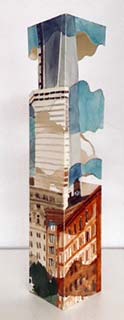 Jean Holabird West Broadway & Duane Street, 10”x2” squared, 2013 (clouds skittering across nearly completed 1 WTC). 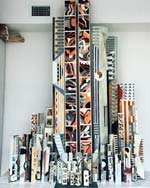 Jean Holabird "Paper City" in artist’s studio, 2019. 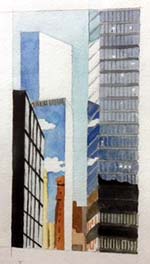 Jean Holabird Warren & Greenwich Streets, 10”x5" watercolor, 2014: what a piece looks like before it is folded and cut. 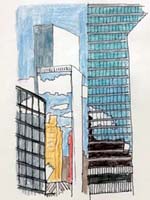 Jean Holabird Murray & Greenwich Streets, a favorite spot for tower-making, with light and shadows constantly changing form. Colored pencil on 7”x4" paper, 2010. 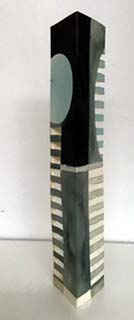 Jean Holabird Reflection in Window (East 40th Street between Lexington & 3rd Avenues; Jitney stop) , 10"x2"x2" triangle, 2010. |
© 2019 ArchNewsNow.com